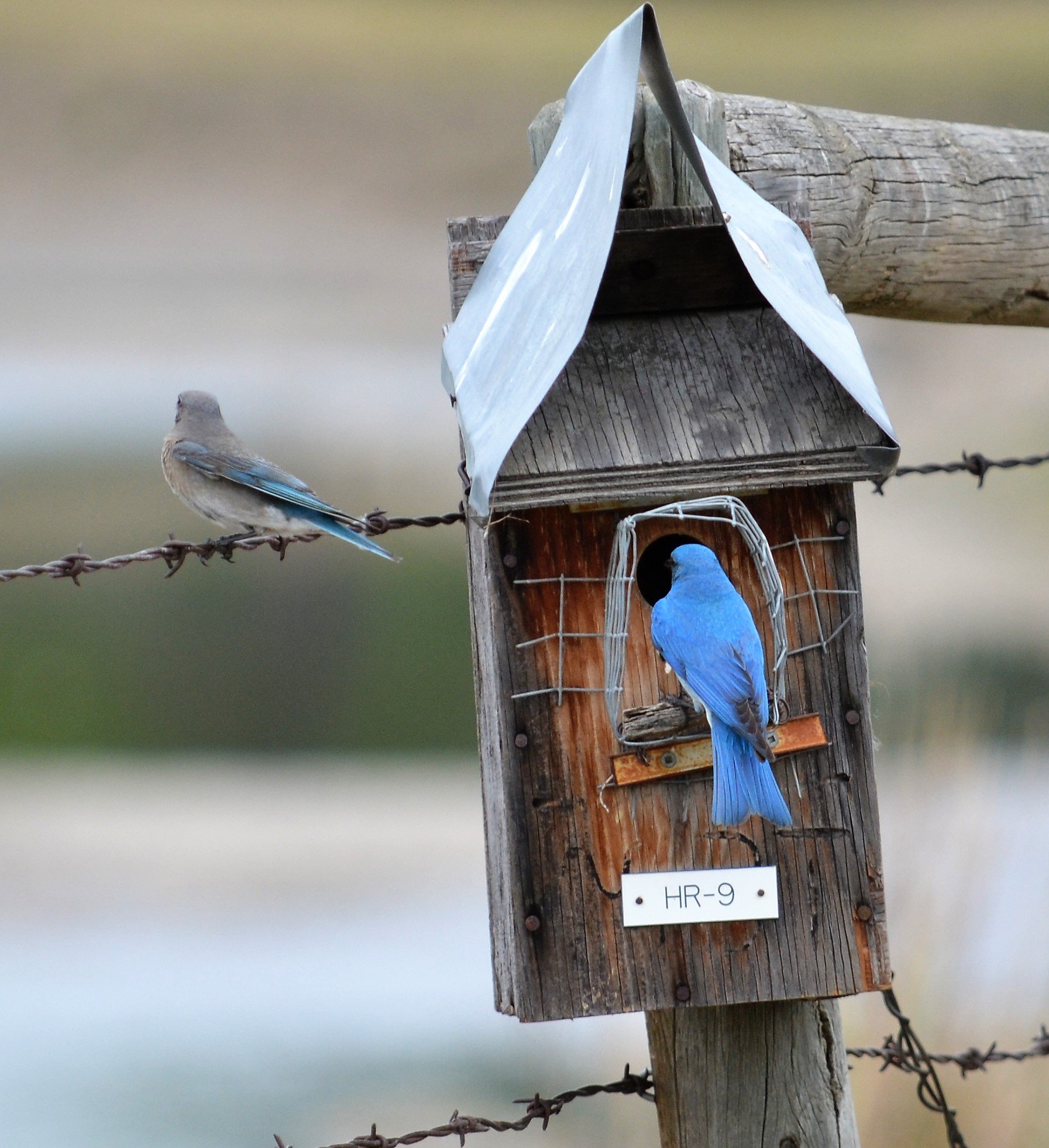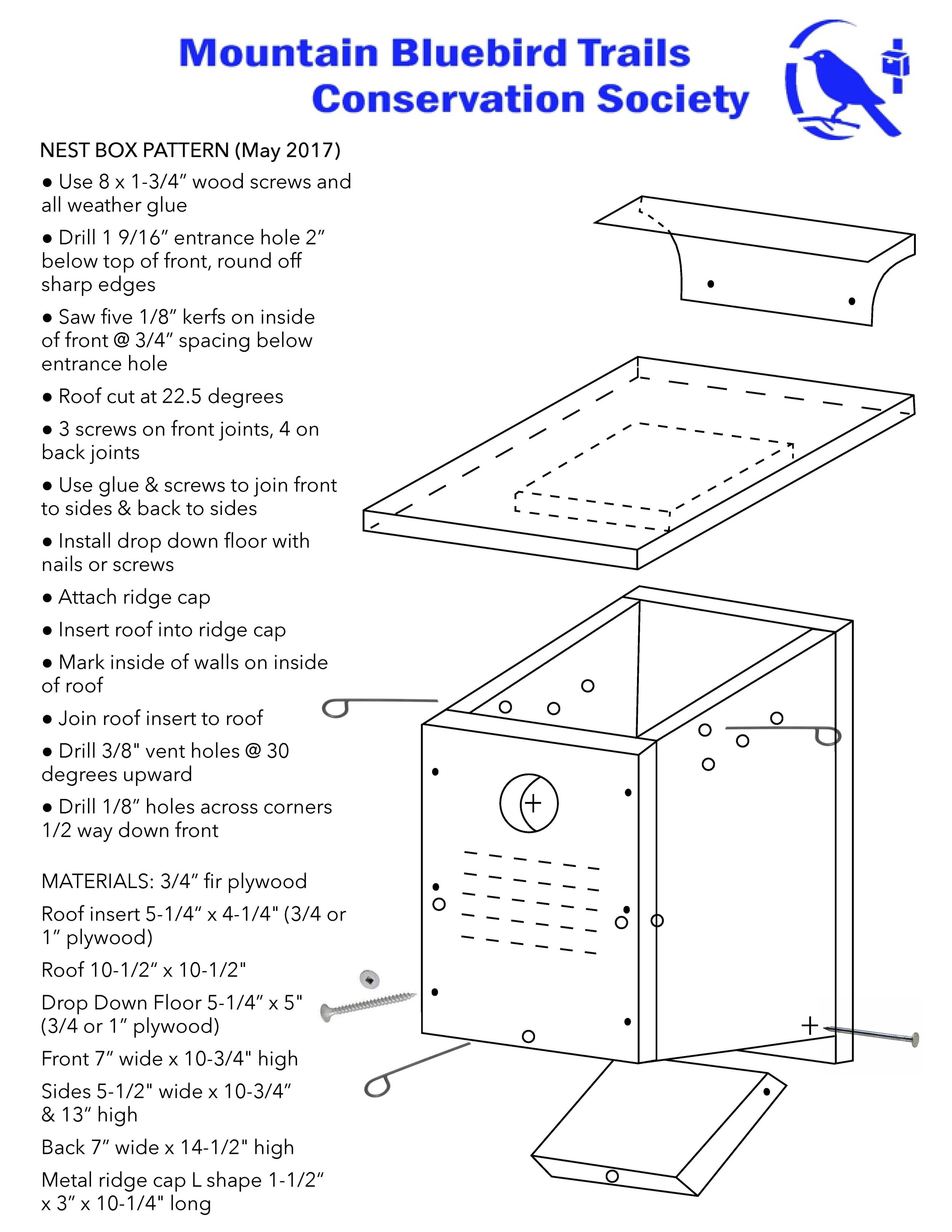Mountain Bluebird Nest Box Building
To support the Mountain Bluebirds ability to remain sustainable, we provide nest boxes, sized to birds the size of a Mountain Bluebird, to replace loss of cavity nesting sites due to land clearing, or other habitat changes.
Mountain Bluebird nest box mounted to pole
Mountain Bluebird nest box with predator guards
A well-built nest box allows us to monitor numbers of live births, band, and track the success of our efforts. Follow the official MBTCS Bluebird Nest Box Building Guide (download below) for complete construction and assembly requirements.
Bluebird nest boxes need not be fancy; wood is the best material to use. Exterior-grade fir or cedar plywood is best, pine is not recommended.
An ideal nest box for bluebirds has a sanded maximum 3.97 cm (1 9/16 inches) diameter entrance hole approximately 5.0 cm (2”) below the front roof top.
The top of the birdhouse should be easily opened for cleaning. It should overhang the entrance hole at a 22.5° degree angle to provide protection from rain. A drop-down floor provides easy annual cleaning.
Two 6-mm (3/8”) holes should be drilled at a 30° degree upward angle near the top of each side for ventilation and two 6-mm holes should be made in the floor for drainage. Remember to pre-drill holes, mounting, and wire securing holes during construction.
Make five shallow 2-mm (1/8”) saw kerfs at 19-mm (3/4”) spacing on the inside front panel, just below the entrance hole.
Perches should not be placed on the birdhouse, as they only encourage House Sparrows to take up residence.
Assemble nest boxes using wood screws (8 x 1 3/4”) - it makes for easier maintenance and renovation.
If an exterior finish is desired to preserve the wood, a wood-stain is adequate. If houses are painted, a light green, brown, or grey should be used. White is too conspicuous, and a white nest box is often shunned by bluebirds. Dark colors absorb heat, which may become too intense for the eggs or young in the nest box.
Do not paint or varnish the inside of the box. The interior walls need a rough surface to aid the bird in climbing up and out.
Nest boxes should be clearly marked on the front side “MBTCS-Year Built ## - Box #” for example: MBTCS-23-2808.
Install a metal ridge cap to waterproof and extend the life of the nest box.
You may want to consider predator guards - these additional enhancements may prevent predation by raccoons, snakes, or corvids.
Use the nest box placement tips below to ensure success of your nest box next season!
Nest Box Placement & Developing New Bluebird Trails
Once you have a well-built nest box it is time to start thinking about where to put it. To have a successful year, you must also think about when to have your nest box put up. Ideally, in Southern Alberta nest boxes should be cleaned or placed and ready by early/mid February.
The location of a bluebird house is important. Houses should be placed in semi-open areas such as pastures, fields, and rural roadsides. A fence post in a clearing with scattered trees about 20-metres away is probably a good location. Bird houses in urban areas or near farm buildings are usually occupied by house sparrows.
Face nest box opening away from prevailing winds, where possible. The strongest winds in Southern Alberta are from the southwest, and spring snowstorms blow in from the northeast. In Southern Alberta face nest box openings to the Southeast or Northwest. This is NOT universal guidance and will largely depend on local factors. We suggest consulting wind rose maps for your specific region - see Prevailing Wind Direction (alberta.ca).
Consider placement hazards - like horses (will chew boxes), cows (will rub against boxes), weasels, raccoon, snakes, ants (will raid boxes), mice (will move into boxes), and areas dominated by House Sparrows (will overtake boxes). Avoid placing boxes in areas that are sprayed with pesticides and herbicides. Busy trails may be more prone to vandalism.
The nest box should be placed a minimum 1-metre or more above the ground, fastened using at least two 3” screws, or bolts. Fence posts or smooth metal posts are ideal for mounting nest boxes, trees or buildings are not recommended.
A “bluebird trail” consists of several nest boxes spaced 200-metres or more apart and in a manner convenient for inspection on foot or by car, to record nesting success, band young birds, and clean out boxes in the fall.
Regular inspections also allow the nest caretaker to remove nests of House Sparrows and other intruders.
Some trails may be only one kilometre long, while the longest runs several hundred kilometres from Winnipeg, Manitoba, to North Battleford, Saskatchewan, with hundreds of kilometres of branch lines leading off from the main trail.
Remember - every nest box that is placed requires annual maintenance and occasional renovation!
WARNING - IMPORTANT LEGAL NOTICE!
In Canada it is illegal to disturb, destroy, or take a nest, egg, or shelter of a migratory bird, or to have in one’s possession a live migratory bird or a carcass, skin, nest or egg of a migratory bird except under authority of a License (permit).
Permits may be required to clean out, empty, treat for parasites, remove nesting material, remove dead nestlings or unhatched eggs, and handle an adult bird or a nestling.



